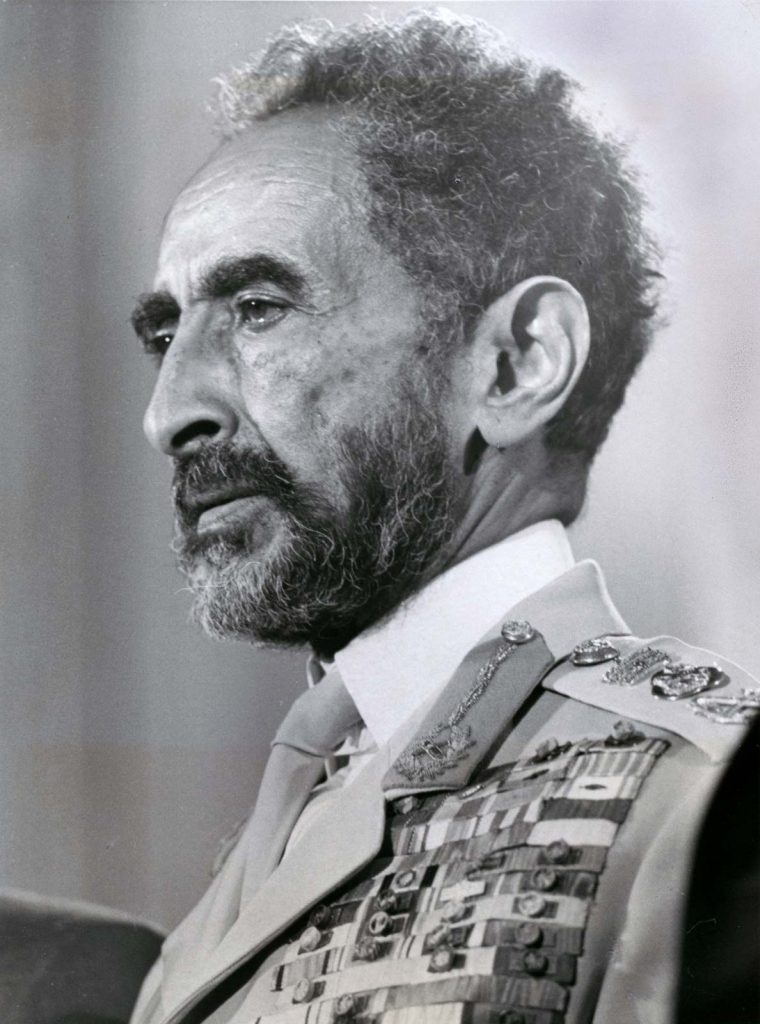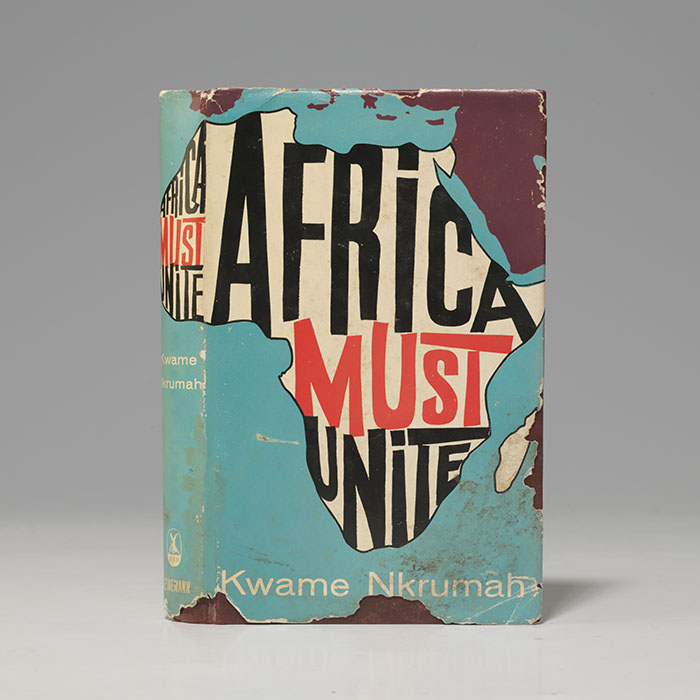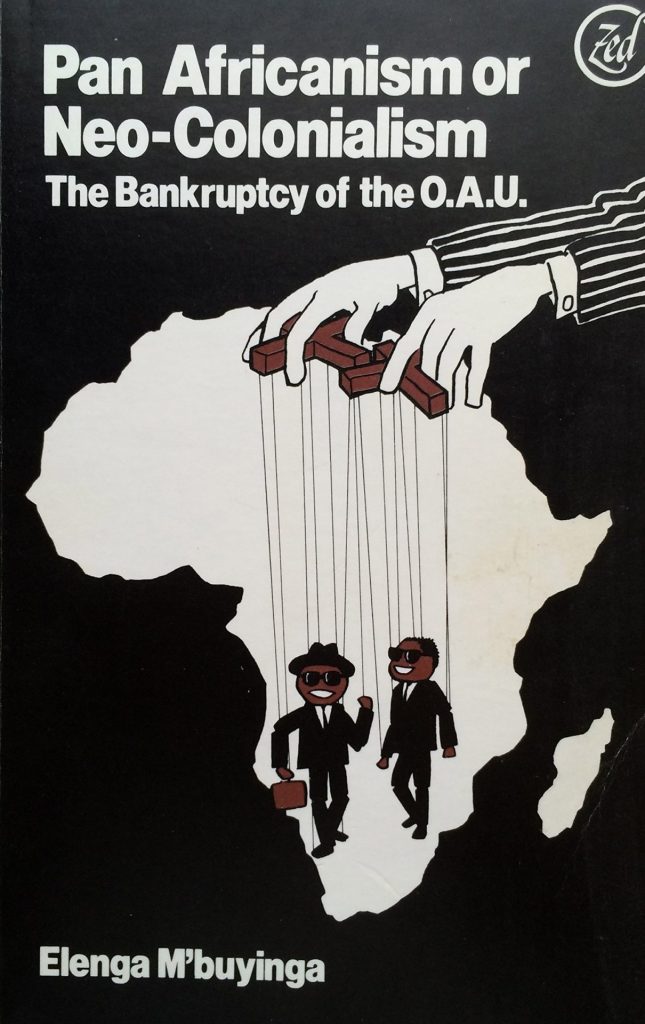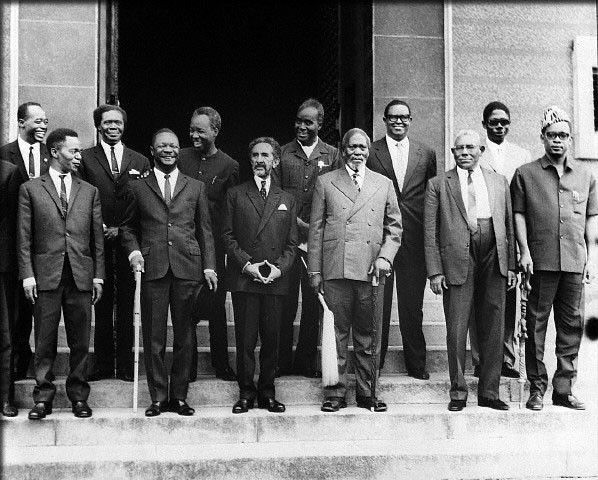Representatives of some of the independent African states participating
at the founding conference of the OAU in May 1963.
A scattered path towards unity
The successful struggle for independence in the colonies that resulted in a wave of independence in 1960 created the conditions to put Pan-African ideas into practice, but also exposed conflicting views as to how the future of an independent Africa ought to look like. Many later problems of the Organisation of African Unity are foreshadowed by previous developments, like disagreement over the nature of political cooperation and the future bonds to the former colonisers.
These conflicting ideas were expressed in the formation of several groups, representing the newly independent African states. While at earlier meetings, such as the Conference of Independent African States in April 1958 in Accra general foreign and domestic policy goals for the independent states were formulated, the more states gained independence the more difficult it became to find common grounds on which to base their policies. This already became obvious at the second Conference of Independent African States in June 1960, when the representative of Ghana proposed close economic and political ties in the form of a supranational organisation. Nkrumah’s first attempt to create a political union of African states was only supported by Guineas President Sékou Touré and President Modibo Keita of Mali, who saw themselves as constituting “the nucleus of a future United States of Africa” (O.E., 1994: 171).
Other governments were reluctant in committing too soon to a political union, which was expressed by the Nigerian delegate who saw a “union of African states [as] premature” (Ibid.). Representatives of the independent African states held additional meetings with more like-minded states and the idea of a Pan-African organisation seemed to disappear and rather two opposing camps developed at the second Conference of Independent African States in June 1960 in Addis Ababa. According to Alanna O’Malley, “the Congo crisis would serve to split the African states between a conservative faction who became known as the Brazzaville group and the more radical Casablanca group in 1961” (O’Malley, 2015: 971).
Brazzaville
The first of this group to form was the ‘Brazzaville group’, named after the place of a conference held in Brazzaville from December 15-19, 1960. Here, the Heads of State of Cameroon, Central African Republic, Chad, Republic of the Congo, Dahomey (now Benin), Gabon, Ivory Coast, Niger, Mauritania, Madagascar, Senegal and Upper Volta (now Burkina Faso) met to discuss their political and economic policies. These former French colonies, which formed from 1961 onwards the Union Africaine et Malgache (UAM), “favoured close co-operation with the former metropole and the preservation of the state system bequeathed by the colonial era” (McKeon, 1966: 393). Hella Pick summarises the Brazzaville groups approach as:
“All were pro-Western, and none wanted to take the plunge away from French technicians and money which might – according to the Guinea or Ghana leaders – bring them ‘real’ independence, but which in their own view might leave them at the mercy of the Communist powers. All twelve believed themselves to be realists and wanted to deal with the Congo and Algeria problems not on the basis of preconceived ideas of what was right or wrong, but on what was possible” (Pick, 1987: 80).
Casablanca
In January 1961, the heads of state of Algeria, Ghana, Guinea, Libya, Mali, Morocco and Egypt formed the Casablanca group as a reaction to the Brazzaville group, whose pro-Western stance and especially their close ties with France was regarded as problematic. The Casablanca groups statement said:
“We proclaim our determination to liberate the African territories still under foreign domination, by giving them aid and assistance, to liquidate colonialism and neo-colonialism in all their forms, to discourage the maintenance of foreign troops and the establishment of bases which endanger the liberation of Africa and to strive equally to rid the African Continent of political and economic interventions and pressure.” (See Woronoff, 1970: 49)
Main disagreements between the groups concerned the Algerian war and the situation in the Congo. The Casablanca group strongly supported the FLN in the Algerian war, while the Brazzaville group was reluctant in order to not alienate France. Moreover, while the Casablanca group strongly condemned the murder of Patrice Lumumba, the Brazzaville group pragmatically arranged good terms with Moise Tshombe.
Monrovia
In light of this split between the independent African states, the idea of a continentwide political unity became rather unlikely. The formation of another bloc, the Monrovia group, which was founded in May 1961 and composed of Liberia, Somalia, Togo, Nigeria, Ethiopia, Sierra Leone, Libya, and Tunisia, seemed at first to aggravate the situation. The Monrovia group was more moderate and met somewhere in the middle between the other two. Its member states were supporters of a united Africa but didn’t see the establishment of a political union as fit to meet the needs of such a diverse continent and did not want to give up their sovereignty. The principle of non-interference in the domestic affairs of other states had priority for its members, but they agreed that economic cooperation and solidarity within the continent as a whole was desirable. The Brazzaville group eventually merged with the Monrovia group, where “the consensus was to establish ‘a loose form of association […] based upon the principles of economic, cultural, scientific and technical co-operation’” (Aforka Nweke, 1987: 137). Aforka Nweke points to the Monrovia Conference resolution stating:
“The unity that […] is aimed to be achieved at the moment […] is not the political integration of sovereign African States, but unity of aspirations and of actions considered from the point of view of African social solidarity and political identity” (Ibid.).
Addis Ababa
Impressions from the Conference in Addis Ababa, 22–25 May 1963.
It was in this context of division and, at the same time, the search for alliances within the continent, that the Organisation of African Unity was founded in 1963. As Nora McKeon points out, it was “the efforts of neutral states like Ethiopia [that] helped to create an atmosphere favorable to reconciliation” (McKeon, 1966: 393) and it is not surprising that the emperor of Ethiopia, Haile Selassie, invited the Heads of State of the independent African nation to Addis Ababa. In Selassie’s speech at the conference it already became obvious that any further proceedings to the goal of unity were going to be based on compromise. He suggests that
“while we agree that the ultimate destiny of this continent lies in political union, we must at the same time recognise that the obstacles to be overcome in its achievement are at once numerous and formidable. Africa’s peoples did not emerge into liberty in uniform conditions. Africans maintain different political systems; our economies are diverse; our social orders are rooted in differing cultures and traditions. Furthermore, no clear consensus exists on the ‘how’ and the ‘what’ of this union.”

Although he recognised differences that stood in the way of a political Union of African states, he was a strong supporter of a united Africa to “avoid the pitfalls of tribalism.” He further went on to warn that if Africa was divided “on tribal lines, we open our doors to foreign intervention and its potentially harmful consequences.” To find common ground between the moderate Monrovia group and the more radical Casablanca group he pragmatically balanced his speech between making clear that a complete union cannot be achieved yet, but that it might be possible through a gradual process to achieve political unity after a “solid foundation is laid.” He calls for the participants to “put an end to these terms [Monrovia, Brazzaville, Casablanca]” and instead to
“create a single institution to which we will all belong, based on principles to which we all subscribe, confident that in its councils our voices will carry their proper weight, secure in the knowledge that the decisions there will be dictated by Africans and only by Africans and that they will take full account of all vital African considerations.”
In his speech, Haile Selassie clearly integrated Pan-African ideas. He stated that “our liberty is meaningless unless all Africans are free” and that they are looking to “the vision of an Africa not merely free but united.” He expressed the necessity to unite Africa economically, politically and military numerous times and even proposed founding an “African University, sponsored by all African States, where future leaders of Africa will be trained in an atmosphere of continental brotherhood” to engrave the idea of Pan-Africanism in the education of future leaders.

For radical Pan-Africanist Nkrumah, on the other hand, this didn’t go far enough, as the transition to political unification had to be immediate, instead of gradual. He was “convinced that the nation-state is obsolete and that Africa’s challenge is not that of building nation-states but that of regenerating a continent” (O.E., 1994: 193). Nkrumah’s position was made clear in his speech at the conference:
Unite we must. Without necessarily sacrificing our sovereignties, big or small, we can here and now forge a political union based on defence, foreign affairs and diplomacy, and a common citizenship, an African currency, an African monetary zone, and an African central bank. We must unite in order to achieve the full liberation of our continent.
Only economic stability would enable political independence and only by uniting politically the African states would be able to distribute the wealth of the continent evenly. In his book “Africa Must Unite”, that was published in the same year, he stated: “So long as we remain balkanised, regionally or territorially, we shall be at the mercy of colonialism and imperialism” (Nkrumah, 1963: 218). The establishment of the OAU as an institution of sovereign nation states was not at all what Nkrumah and other Pan-Africanists had imagined African unity to be. Considering the division of the continent that had unfolded in the previous years, however, it was the lowest common denominator and Nkrumah’s radical ideas found only few supporters.
Purpose and Principles: The Charter of the OAU
According to the Charter (PDF), the Heads of State of the already independent nations were
“Inspired by a common determination to promote understanding among our peoples and cooperation among our states in response to the aspirations of our peoples for brother-hood and solidarity, in a larger unity transcending ethnic and national differences,
Convinced that, in order to translate this determination into a dynamic force in the cause of human progress, conditions for peace and security must be established and maintained,
Determined to safeguard and consolidate the hard-won independence as well as the sovereignty and territorial integrity of our states, and to fight against neocolonialism in all its forms.”
The goals formulated were the promotion of unity and solidarity of the African States; their cooperation along economic, cultural and political lines; the defense of their sovereignty; their territorial integrity and independence; and the eradication of all forms of colonialism from Africa. Eventually the member states agreed on the following principles (amongst others): The sovereign equality of all member states, non-interference in the internal affairs of states, respect for the sovereignty and territorial integrity of each state and for its inalienable right to independent existence, peaceful settlement of disputes by negotiation, mediation, conciliation or arbitration.
Shortcomings and Criticism
The climate of compromise in which the conference was held was subsequently reflected in the Charter of the Organisation of African Unity, which was adopted at the meeting. As promising as the goals formulated seem at first, disagreement between the participating states impeded their successful implementation. Often criticised is the fact that it the Organisation of African Unity has been centered at the leaders of its member states and has not sufficiently considered the populations of the respective countries. As P. Mweti Munya points out,
“The preamble of the OAU Charter opens with the following words: ‘We, the Heads of African States and Governments […] have agreed to the present Charter.” This language underscores the predominant and exclusionist role that the African heads of state have played in the formation of the OAU. Contrast this preamble with that of the United Nations Charter, which starts with these words: ‘We the peoples of the United Nations’ the prefatory language to the United Nations Charter emphasises the centrality of the people in the aims and objectives of the United Nations. The success or failure of the OAU is, therefore, consequently intertwined with the weaknesses or strengths of the African heads of state: an indictment on the OAU is an indictment on the African states’ leadership” (Mweti Munya, 1999: 543). Earlier meetings, such as the All-African Peoples’ Conference held in Accra, Ghana, in December 1958 attempted to achieve African unity on a non-governmental level. Political leaders of independence movements, Labor Union members, representatives of anti-colonial associations, as well as the Heads of State already independent nations were present and, “according to its organisers, the purpose of the conference was a) to give encouragement to nationalist leaders in their efforts to organise political independence movements, and b) to plan strategy for nonviolent revolution in Africa” (Johnson 1962: 429). Lumumba was present and stated in his speech:
The winds of freedom currently blowing across all of Africa have not left the Congolese people indifferent. Political awareness, which until very recently was latent, is now becoming manifest and assuming outward expression, and it will assert itself even more forcefully in the months to come. We are thus assured of the support of the masses and of the success of the efforts we are undertaking.
He clearly includes and speeks for “the Congolese people” and, as the below footage shows, the message of the conference was “People of Africa Unite!”.
The OAU clearly missed out in including the people of Africa in their attempt to achieve unity and didn’t convey a feeling of belonging. It exclusively represented the Heads of State and therefore had no influence on issues that involved non-governmental actors, like rebel groups.
The leftist writer and political activist Elenga M’buyinga criticises the OAU as being only Pan-Africanist in name and that the revolutionary Casablanca group didn’t succeed in including real Pan-Africanist unity into the OAU.
“[T]he real cause of revolutionary Pan-Africanism’s downfall was that, instead of trying to achieve this unity through the efforts of those who had most to gain, the African workers and peasants, it put its hopes in heads of state. In other words, it tried to bring about African unity ‘from above’, despite the fact that many, indeed most, of these heads of state were notorious reformists, not to say outright reactionaries, linked in a thousand and one ways to international imperialism.” (M’buyinga, 1982)
The cover of his book “Pan Africanism or Neo-Colonialism. The Bankruptcy of the O.A.U”, which was published in 1975 by the Camerounian Peoples’s Union, depicts the way the OAU was seen by many and is still remembered today: Its leaders were simply puppets on a string, operated by Western imperialists. This echoes Sapin’s critical description of African politicians as not being autonomous, and rather “awaiting a noose dangling behind them, held by their Western European partners.”

Mueni Wa Muiu’s analyses this perception as a characteristic of the postcolonial state. According to him, “the postcolonial state inherited the mistrust, fear, and hate that the majority of the people felt toward the colonial state as a foreign entity that was imposed on them. […] Citizens were further marginalised from the institutions of power. The state became the major source of wealth and, therefore, the most sought-after office” (wa Muiu, 2010: 1318).
Disillusionment and disappointment of African citizens at their political leaders is also expressed by Sapin Makengele. For him, African politicians are not autonomous but rather guided and manipulated by outside powers. Instead of Pan-Africanists, the Heads of State who comprise the OAU are “African capitalists.” He recalls that in his childhood he would hear people say: “The Organisation of African Unity is going to do something, it’s going to organise” but it would never lead to positive results, if any. He further points out, that a lot of people in the Congo share his negative sentiments about the OAU, while others “don’t even know how these organisations operate” and hereby demonstrates the insignificance that many feel towards the OAU, or other international organisations.
Eventually, the OAU turned out to be what Nkrumah or Lumumba would never have wanted African unity to look like: controlled by capitalist interests, by leaders of whom some soon tturned out to be autocratic rulers, and not by the people of Africa, representing Pan-African ideals. In his speech at the Conference in Addis Ababa where the OAU was founded, Haile Selassie ended with the following:
“A century hence, when future generations study the pages of history, seeking to follow and fathom the growth and development of the African continent, what will they find of this Conference? Will it be remembered as an occasion on which the leaders of a liberated Africa, acting boldly and with determination, bent events to their will and shaped the future destinies of the peoples? Will this meeting be memorialised for its solid achievements, for the intelligence and maturity which marked the decisions taken here?
Or will it be recalled for its failures, for the inability of Africa’s leaders to transcend local prejudice and individual differences, for the disappointment and disillusionment which followed in its train.”
Ironically, the latter came true, not even a century later but rather within the first years after the Organisation of African Unity’s creation. Its failures have overshadowed its successes and for many people the OAU simply doesn’t play a significant role in anything. What Haile Selassie didn’t even consider was the possibility of the Organisation of African Unity being simply forgotten in the historical narrative. This happened in the case of Sapin’s painting, where the OAU is not depicted. Not because he chose to leave it out, but it simply didn’t occur to him to even include them. As this analysis shows, it is not always the powerful that control the historical narrative. In this case, the members of the OAU certainly would have wanted to be included in a painting of the crisis, simply for the fact that they tried to find a solution and did not see themselves as irrelevant. It was surely against the spirit of its prominent figures, like Haile Selassie, to be simply left out of the story at all. Because of their failure of effectively reconcile the conflict, however, their role doesn’t have any relevance for Sapin.
When cases such as the Congo Crisis tested the organisation’s members ability to cooperate, weaknesses quickly became evident. This leads to an explanation of why the OAU failed to bring about a solution in the Congo Crisis and helps to understand why the OAU is not really considered important by many Africans, as described by Sapin Makengele in the interview. In the folowing part, this will be further analysed.
Images:
Header: https://www.sahistory.org.za/article/organisation-african-unity-oau
(1) https://www.britannica.com/biography/Haile-Selassie-I
(2) https://www.baumanrarebooks.com/rare-books/ali-muhammad-nkrumah-kwame/africa-must-unite/109345.aspx
(3) photographed by Corinna Billmaier


